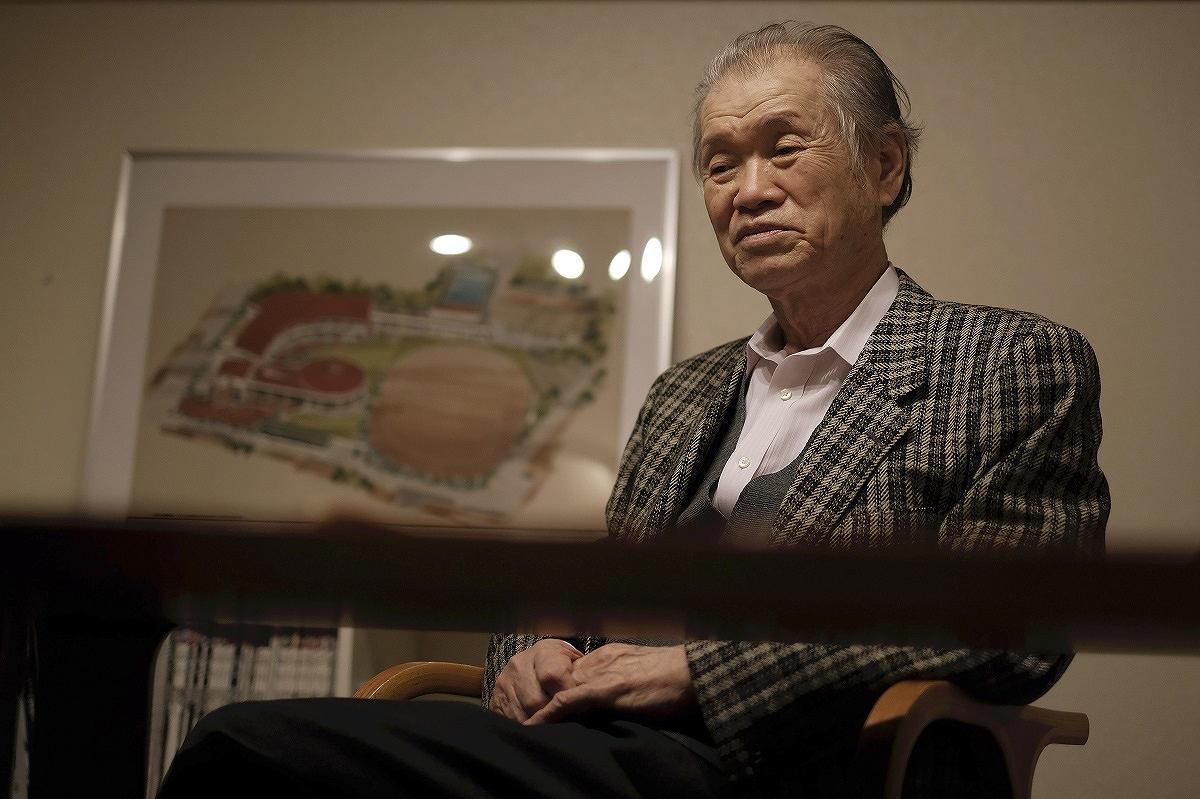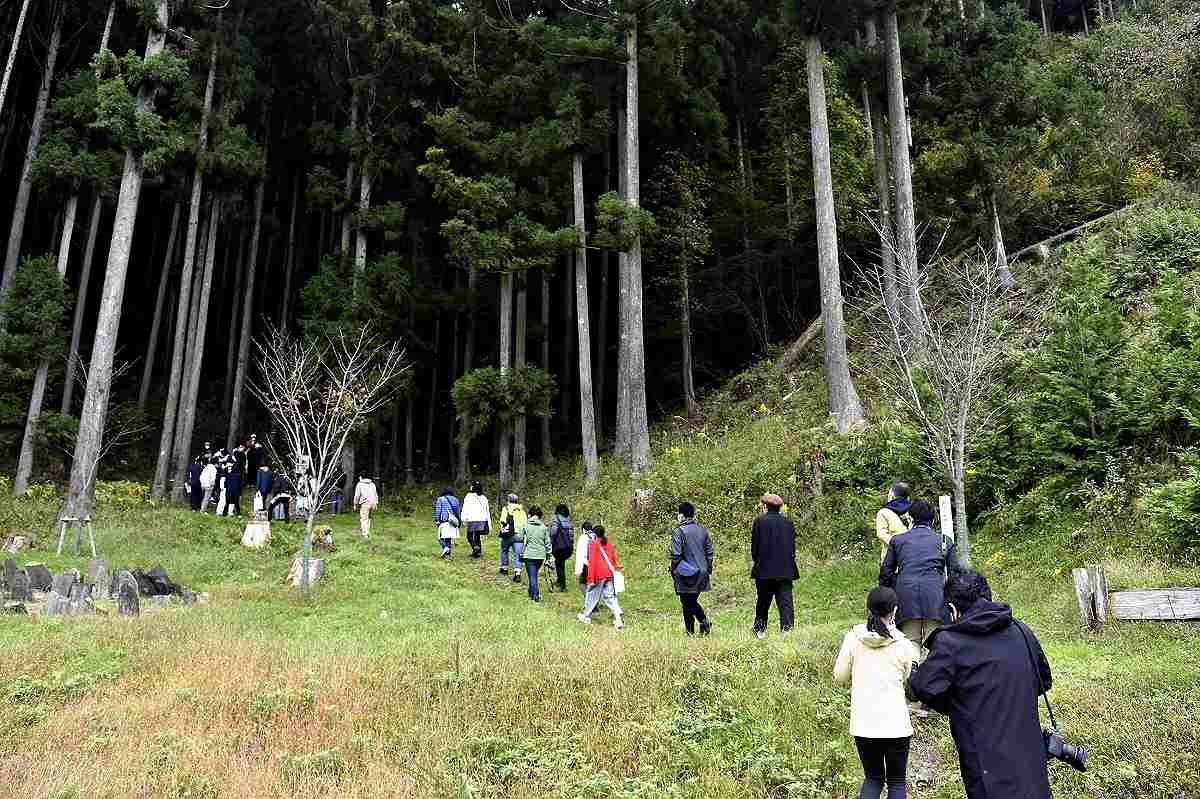
Architect Koichi Kitazawa, who designed the Okawa Elementary School building in Ishinomaki, Miyagi Prefecture, is seen in Shibuya Ward, Tokyo, in November last year.
12:12 JST, January 22, 2021
What happened at Okawa Elementary School in Ishinomaki, Miyagi Prefecture, following the Great East Japan Earthquake in March 2011 was a nightmare. Seventy students were found dead, 10 teachers also perished, and the bodies of four schoolchildren are still missing.
The tsunami caused by the quake ran up the Kitakami River for nearly 4 kilometers and engulfed the line of teachers and students who were unable to escape. A village of about 100 households in the area disappeared, and today only the school building remains with its distinct design incorporating many curved lines.
The architect who designed the building has told The Yomiuri Shimbun about a project for the school that never materialized, which could have saved many lives.
The school building, which opened in 1985, was designed by Tokyo architect Koichi Kitazawa, 83. Kitazawa studied under Antonin Raymond (1888-1976), who is known for his involvement in the design of the former Imperial Hotel in Tokyo and for teaching many Japanese architects.
The buildings designed by Kitazawa include a Sophia University campus building in the Yotsuya neighborhood of Shinjuku Ward, Tokyo, and Rikkyo University’s dormitory for female students in Tokyo’s Ikebukuro area. Kitazawa’s wife comes from the former town of Kahoku, which is now part of Ishinomaki. This connection led to the town commissioning Kitazawa to design a public school for the city.
“I tried to make a school building that children could use happily,” said Kitazawa, recalling his thoughts when he faced the drawing board. He used movable walls between trapezoid-shaped classrooms so that the classrooms could be connected to let many students study together.
Specially ordered unglazed tiles adorned the exterior. Kitazawa made the ceilings 2 meters higher than usual, with ceilings in the classrooms on the second floor being 5 meters high. The open, pleasant building came complete with large windows that let in a lot of sunshine.
The earthquake occurred 26 years later, and a delay in evacuation guidance caused the tragedy at the school. Having learned that many children died in the tsunami, Kitazawa immediately recalled a project for the school he proposed a quarter of a century ago.
The project was meant to encourage outdoor education activities for the school, in which students could go outside and learn about nature and society, while looking over the Kitakami River and the town where they live. The project involved paving a path on the hill behind the school and constructing an azumaya gazebo at a height of more than 10 meters above the ground. The town seemed to like the idea, but the hill was private property, so it never came to be.
The estimated height of the tsunami that devastated the school was 8.6 meters.
Kitazawa still vividly remembers the smiles of the children running inside the new school building on the day he attended its inauguration ceremony.
“It’s too late to bring this up again, but couldn’t the children have climbed up the hill and avoided the worst if the gazebo had been there?” Kiazawa asked.
The school building will be open to the public this spring as a relic commemorating the tragedy.
■Lingering question unanswered

People walk on one of the routes to the hill behind the school in October last year. The slope is not steep.
About a month after the earthquake, Kitazawa went to Ishinomaki from Tokyo and visited the site of the school. He wanted to find an answer to a question lingering in his mind: Why didn’t they run to the hill behind the school?
After avoiding severed roads, he finally arrived at the school. Both the building and the playground were filled with debris. The glass-walled corridor connecting the gym and the school building had collapsed, and its support pillars had cracked from the base.
A non-Japanese reporter approached Kitazawa and asked him what connection he had to the school, but he walked away without a word, not revealing his identity.
Kitazawa then walked toward the hill, the site where the outdoor school activities he had envisaged would have taken place. When he got close to the hill, he could see that the tsunami did not reach the site.
He still feels it would have been possible to climb up the hill. His heart ached for the children who were swept away by the tsunami.
“I heard that many elderly people in the neighborhood had also gathered at the school. Maybe [the facts at hand] didn’t lead to the decision to run to the hill together with everyone,” Kitazawa said.
■Fearing landslides, teachers led students toward the sea
The children hid under their little desks as Okawa Elementary School trembled with the fury of a seismic quake measuring an upper 6 on a scale that maxes out at 7. As the tremblor subsided, the teachers acted quickly, using the precious limited time before the inevitable aftershocks to usher the students out onto the open schoolyard grounds. The faculty had drilled for such scenarios. They had been instructed to exit the school, and up to that point, they had followed the prescribed evacuation procedure by the book. The problem now was that they had reached the last page of their manual, and nobody seemed to agree on how to proceed next.
The time was 3 p.m. As the aftershocks struck, school staff tried to calm the children, escorting them back into the building to use the restroom as needed. Those outside shivered in the sleety, snowy, 1.4 C weather not atypical of Miyagi Prefecture in March. Teachers had their hands full dealing with the parents and guardians who had begun to arrive to pick up their children, as well as the community members who had begun to amass at the school, which happened to be a designated evacuation site for the neighborhood.
A ruling filed in civil court corroborated sources saying some teachers had suggested evacuating to the hill behind the school. It was the same hill where the students were taken each spring to grow shiitake mushrooms, as part of an out-of-the-classroom learning experience. Some parents reportedly urged the pupils to escape up the hill and away from the incoming tsunami. Some students begged to be allowed to evacuate to higher ground.
But there were reasons to fear the hill. It had been designated a landslide hazard by the Miyagi prefectural government in 1985, and an artificial slope had indeed collapsed in 2003, sending a wall of soil toppling toward the school. Such considerations were ostensibly on the mind of the elementary school’s vice-principal, who had been placed in charge as the principal happened to be absent that day. Witnesses attested to seeing the vice-principal asking a local community leader about a possible evacuation plan, only to be told, “There’s no way a tsunami will reach us here.” The vice-principal would not survive the day.
The decision was at last made to vacate the school grounds around 3:35 p.m., after an Ishinomaki city government vehicle equipped with loudspeakers passed by to urge evacuation now that the tsunami had breached the coastal area. Approximately 50 minutes had passed since the children were first corralled into the schoolyard.
The teachers chose to evacuate to a triangular clearing at an elevation nearly 6 meters higher than the school. But before the group could reach the clearing, they were swallowed up by the tsunami that had already traversed the nearby Kitakami river. Most of the eleven teachers present at Okawa Elementary that day were relatively new; only three had more than two years of experience teaching at the school.
Once the waters receded, family members began to search the site for their missing loved ones. Parents clawed away debris and dug until they finally located the bodies. There were too many to transport them all to a nearby morgue. The survivors could merely lay each new body out on that same triangular clearing.
The bereaved families demanded an investigation from the city government, which interviewed those survivors who managed to evacuate to the triangle. But the families never received the sort of conclusive response they had hoped for in order to receive closure. The frustrations and misgivings bubbled over three years later, when the families filed suit in civil court against the city and prefectural governments.
Both the Sendai District Court and the Sendai High Court ruled in favor of the families. The district court found fault with the teachers, citing three evacuation routes that would have likely enabled the students to reach the hill in as little as one to two minutes. The high court similarly determined that the evacuees could have left the school immediately after the earthquake and avoided the tsunami if higher ground a mere 700 meters away from the school had been designated as an evacuation site.
Now, the school has been preserved with plans to open it to the public from April as a palpable reminder of the disaster. Visitors will not be allowed to enter the remnants of the school itself, but instead will be able to view the structure from a nearby facility, where photos and other items will also be on display. The land surrounding the school, which was once a residential area, will largely be left an open clearing as a memorial to the lives lost.
Not all the family members were keen on the idea of keeping the building as a reminder of what transpired that day nearly a decade ago. Out of the 74 children who lost their lives in the tsunami, the families of 23 joined the lawsuits. One said, “It’s too painful to look at, I wish they would just tear it down.” Other parents are still searching for any trace of their children.
But after all is said and done, perhaps the hill itself will be the memorial that stands eternal, as a silent witness to tragedy.

Okawa Elementary School in Ishinomaki, Miyagi Prefecture, is seen on April 11, 2011, showing damage from the Great East Japan Earthquake a month earlier.
"Society" POPULAR ARTICLE
-

M4.9 Earthquake Hits Tokyo, Neighboring Prefectures
-

M7.5 Earthquake Hits Northern Japan; Tsunami Waves Observed in Hokkaido, Aomori and Iwate Prefectures
-

Tsukiji Market Urges Tourists to Avoid Visiting in Year-End
-

Israeli Tourists Refused Accommodation at Hotel in Japan’s Nagano Pref., Prompting Protest by Israeli Embassy and Probe by Prefecture
-

M5.7 Earthquake Hits Japan’s Kumamoto Pref., Measuring Upper 5 Intensity, No Tsunami Expected
JN ACCESS RANKING
-

Keidanren Chairman Yoshinobu Tsutsui Visits Kashiwazaki-Kariwa Nuclear Power Plant; Inspects New Emergency Safety System
-

Imports of Rare Earths from China Facing Delays, May Be Caused by Deterioration of Japan-China Relations
-

University of Tokyo Professor Discusses Japanese Economic Security in Interview Ahead of Forum
-

Japan Pulls out of Vietnam Nuclear Project, Complicating Hanoi’s Power Plans
-

Govt Aims to Expand NISA Program Lineup, Abolish Age Restriction






















